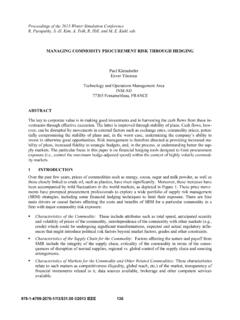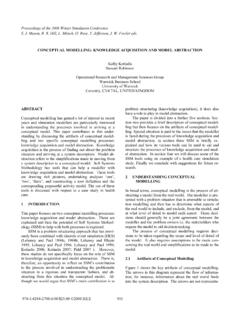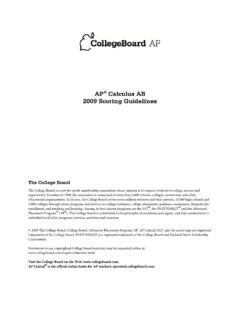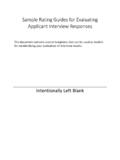Transcription of VERIFICATION AND VALIDATION OF SIMULATION MODELS
1 Proceedings of the 2011 Winter SIMULATION Conference S. Jain, Creasey, J. Himmelspach, White, and M. Fu, eds. VERIFICATION AND VALIDATION OF SIMULATION MODELS Robert G. Sargent Syracuse University Department of Electrical Engineering and Computer Science L. C. Smith College of Engineering and Computer Science Syracuse, NY 13244, ABSTRACT In this paper we discuss VERIFICATION and VALIDATION of SIMULATION MODELS . Four different approaches to de-ciding model validity are described, a graphical paradigm that relates VERIFICATION and VALIDATION to the model development process is presented, and various VALIDATION techniques are defined.
2 Conceptual mod-el validity, model VERIFICATION , operational validity, and data validity are discussed and a way to document results is given. A recommended procedure for model VALIDATION is presented and model accreditation is briefly discussed. 1 INTRODUCTION SIMULATION MODELS are increasingly being used to solve problems and to aid in decision-making. The de-velopers and users of these MODELS , the decision makers using information obtained from the results of these MODELS , and the individuals affected by decisions based on such MODELS are all rightly concerned with whether a model and its results are correct.
3 This concern is addressed through model VERIFICATION and VALIDATION . model VERIFICATION is often defined as ensuring that the computer program of the comput-erized model and its implementation are correct and is the definition adopted here. model VALIDATION is usually defined to mean substantiation that a computerized model within its domain of applicability pos-sesses a satisfactory range of accuracy consistent with the intended application of the model (Schlesinger et al. 1979) and is the definition used here. A model sometimes becomes accredited through model ac-creditation. model accreditation determines if a model satisfies specified model accreditation criteria ac-cording to a specified process.
4 A related topic is model credibility. model credibility is concerned with developing in (potential) users the confidence they require in order to use a model and in the information derived from that model . A model should be developed for a specific purpose (or application) and its validity determined with respect to that purpose. If the purpose of a model is to answer a variety of questions, the validity of the model needs to be determined with respect to each question. Numerous sets of experimental conditions are usually required to define the domain of a model s intended applicability.
5 A model may be valid for one set of experimental conditions and invalid in another. A model is considered valid for a set of exper-imental conditions if the model s accuracy is within its acceptable range, which is the amount of accuracy required for the model s intended purpose. This usually requires identifying the model s output variables of interest ( , the model variables used in answering the questions that the model is being developed to answer) and specifying the required acceptable range of accuracy for each variable. The acceptable range of accuracy for each model variable of interest is usually specified as the range that the difference be-tween that model variable and the corresponding system variable can have for the model to be valid.
6 The amount of accuracy required should be specified prior to starting the development of the model or very early in the model development process. If the variables of interest are random variables, then properties 183978-1-4577-2109-0/11/$ 2011 IEEES argent and functions of the random variables such as means and variances are usually what is of primary interest and are what is used in determining model validity. Several versions of a model are usually developed prior to obtaining a satisfactory valid model . The substantiation that a model is valid, , performing model VERIFICATION and VALIDATION , is generally considered to be a process and is usually part of the (total) model development process.
7 It is often too costly and time consuming to determine that a model is absolutely valid over the com-plete domain of its intended applicability. Instead, tests and evaluations are conducted until sufficient con-fidence is obtained that a model can be considered valid for its intended application (Sargent 1982, 1984a). If a test determines that a model does not have sufficient accuracy for any one of the sets of ex-perimental conditions, then the model is invalid. However, determining that a model has sufficient accu-racy for numerous experimental conditions does not guarantee that a model is valid everywhere in its ap-plicable domain.
8 Figure 1 shows the relationships between model confidence and (a) cost (a similar relationship holds for the amount of time) of performing model VALIDATION and (b) the value of the model to a user. The cost of model VALIDATION is usually quite significant, especially when extremely high model confidence is required. Figure 1: model confidence The remainder of this paper is organized as follows: Section 2 presents the basic approaches used in deciding model validity, Section 3 describes a graphical paradigm used in VERIFICATION and VALIDATION , and Section 4 defines VALIDATION techniques. Sections 5, 6, 7, and 8 discuss data validity, conceptual model va-lidity, computerized model VERIFICATION , and operational validity, respectively and Section 9 describes a way of documenting results.
9 Section 10 gives a recommended VALIDATION procedure, Section 11 contains a brief description of accreditation, and Section 12 presents the summary. 2 BASIC APPROACHES There are four basic decision-making approaches for deciding whether a SIMULATION model is valid. Each of the approaches requires the model development team to conduct VERIFICATION and VALIDATION as part of the model development process, which is discussed in Section 3. One approach, and a frequently used one, is for the model development team itself to make the decision as to whether a SIMULATION model is valid. A subjective decision is made based on the results of the various tests and evaluations conducted as part of the model development process.
10 It is usually better, however, to use one of the next two approach-es for determining model validity. If the size of the SIMULATION team developing the model is small, a better approach than the one above is to have the user(s) of the model heavily involved with the model development team in deciding the va-lidity of the SIMULATION model . In this approach the focus of determining the validity of the SIMULATION model moves from the model developers to the model users. Also, this approach aids in model credibility. Another approach, usually called independent VERIFICATION and VALIDATION (IV&V), uses a third (in-dependent) party to decide whether the SIMULATION model is valid.








